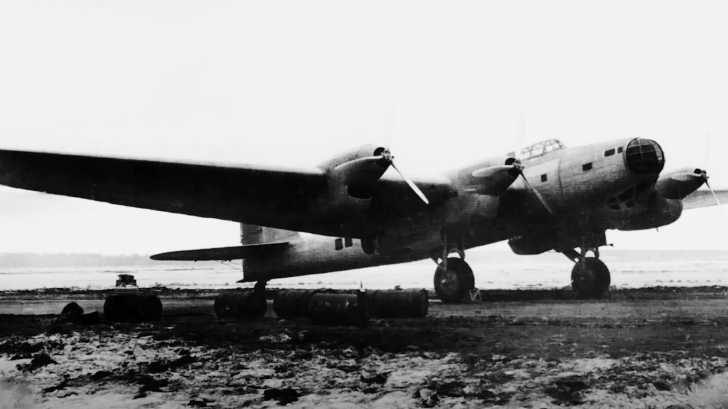The Petlyakov Pe-8 was a Soviet heavy bomber developed during WWII. It was designed by Vladimir Petlyakov in 1939 and was one of the largest aircraft built in the Soviet Union at that time. Despite its size and capabilities, the Pe-8 was plagued by problems, forcing the Soviets to retire the bomber earlier than expected. Here’s how:
Promising Design
The Pe-8 had a range of 2,300 mi and was capable of carrying a heavy bomb load of up to 11,000 lbs. It was primarily used for strategic bombing missions, though it also saw limited use as a transport aircraft. The bomber had a wingspan of 128 feet and a length of 76 feet, with a high-wing configuration that provided good lift and stability.
However, its design was too complex to build, and the Great Purge further delayed production for two years due to the scarcity of resources and a shortage of workers.
Engine Problems
Production of its superchargers wasn’t organized in a systemic way, leading to only the first four Pe-8s being equipped with them. Soviet officials would later proceed with the production without superchargers, but the unavailability of its Klimov M-100 engine meant it also required a design change. To make matters worse, the production of its new AM-34FRNV engines ended in 1939, only having at least two Pe-8s fitted with those engines.
By the 1940s, the Soviets had tried the Charomskiy ACh-30 and M-40 diesel engines, but neither of these was satisfactory despite increasing the range of the Pe-8s. Finally, by the end of 1941, all available Pe-8s were re-engined with AM-35As. Still, the production was slow since it shared the same factory with the higher-priority and more successful Pe-2 light bomber.
Design Limitations
Pe-8s were still slower than the Lancasters, Liberators, and Greifs by only having a top speed of 275 mph. In addition, this heavy bomber could only carry up to 11,000 lbs of payload, while its contemporaries carried more and delivered it farther. Lastly, its slow speeds and low maneuverability made it very vulnerable to enemy fighter aircraft and anti-aircraft fire.
Nevertheless, the heavy bomber did carry eight guns in total. There were two 20mm ShVAK cannons on the dorsal and tail turrets, two 12.7mm UBT machine guns on the nacelles, and another two 7.62mm ShKAS machine guns on the nose turret.
Operational Difficulties
This website lists the losses of Pe-8s from December 1940 to 1944. In 1941 alone, its first year of service, 14 Pe-8s were lost. Half of those losses came from bombardments, the other half from accidents and forced landings. In 1942, 12 planes were lost due to accidents and emergency landings again.
By 1943 and 1944, most of its losses came from the hands of enemy fighter planes.
As A Result
The losses of Pe-8s steadily increased from 1 aircraft per 103 flights in 1942, to one per 46 sorties in 1944. At one point, the Soviets were losing aircraft almost as fast as they were being replaced.
Pe-8s were quickly removed from combat after the war. They were used as testbeds for trials and even as a mother ship for the experimental rocket-engined Bisnovat 5.
Other Pe-8s were used for polar exploration by removing military equipment and installing more fuel tanks.



